Games at Sea
Deck quoits, shuffle-board, Bull-board, and other games are provided on the deck without any charge, under the direction of the quartermaster. Chess, dominoes, and other indoor games can be obtained on application to the library steward.
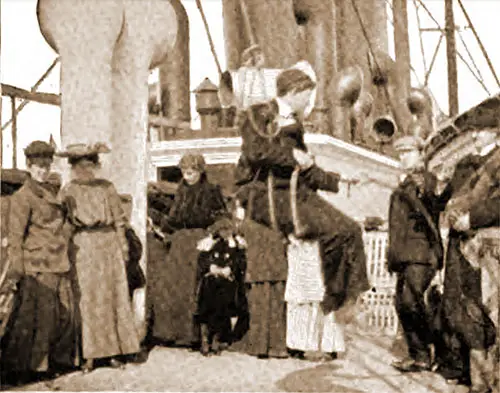
Anyone for a Game of Rope Tag? Passengers Playing this Game on the Deck of a German Ocean Liner. GGA Image ID # 17a8f906f4
Deck Games and Amusements on Steamships
Deck quoits, shuffle-board, Bull-board, and other games are provided on the deck without any charge, under the direction of the quartermaster.
Chess, dominoes, and other indoor games can be obtained on application to the library steward.
Games of cards are also permitted in the lounging or other public rooms.
Gentlemen should be very cautious about playing cards, or other games, with strangers, as professional gamblers are constantly crossing the Atlantic, looking out for the unwary.
There is nothing unusual in the captain posting a notice in the smoking-room warning passengers against gamblers. Games of chance are not usually allowed on Sundays in any of the public apartments in deference to the greater number of passengers' views.
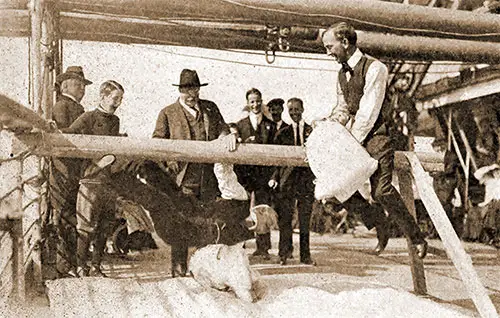
Ex-President Roosevelt Umpires a Pillow Fight at Sea. GGA Image ID # 17a6089fb0
The pillow fight on the spar is a source of great amusement. Two men armed with pillows sit astride the spar and try to knock each other off. It requires a great deal of knack to keep one's balance while someone is pounding you with pillows. The players are not allowed to touch the spar with their hands.
When a man begins to waver, the other redoubles his attack, and slowly but surely, the defeated player tumbles off the spar into the canvas, which has been spread to save him. One of our engravings shows Ex-President Theodore Roosevelt acting as umpire in a pillow fight.
The principal outdoor games provided for the amusement of the passengers during the voyage are known as bull-board, shuffle-board, and quoits.
Bull Board
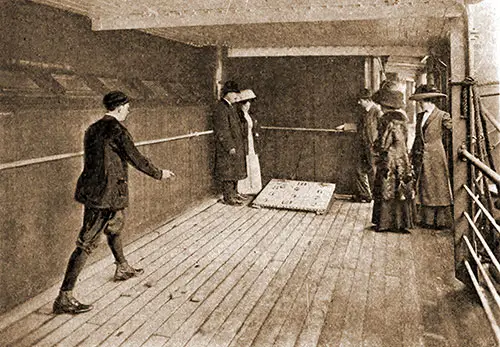
Passengers Enjoy a Game of Bull Board on a Sheltered Promenade Deck. GGA Image ID # 17956b42f0
The bull-board is a large flat board, about the size of an ordinary kitchen-table, and covered with black canvass stretched tightly over it and nailed at the edge or back.
White lines are painted across the face of the board, dividing it into twelve squares, on each of which a number is clearly painted.
The sloping board is marked off into nine divisions, all of which are numbered except the two upper corner ones, which have a bull's head painted upon them.
The players are provided with flat pieces of lead covered with leather, and these they throw upon the board, standing at a distance of a few feet. Each player has four throws, and his score is reckoned according to the value of the squares upon which the leads pitch.
However, any lead, pitching upon either of the squares marked with a bull's head, deducts ten from the score. Leads lying upon a line do not count.
"Bull Board" is one of the favorite games at sea. It is played with the aid of a padded board, which is like an inclined plane. This board has numbers upon it; also, a square lettered "B." Rubber disks or little bags of sand are thrown at the hoard, the aim being to get the discus or the little bag of sand on the highest numbers.
Six disks are used in playing the game, and the one having the highest score wins. If a disk falls on the "B" the player is disqualified, or else he loses his score and is obliged to begin again. Any disks knocked off numbered spaces are lost.
The game can be played as follows: —The board is laid on the deck, and something usually placed under the further end to raise it about a foot. A chalk mark is drawn a few yards off, and the object of the game is to throw small leaden weights, about the size of an old-fashioned turnip watch, on to the prize squares, a bystander keeping account of the scores made by the respective players. Of course, the rules of this game can be varied.
Deck Quoits - Game Played by Cabin Passengers
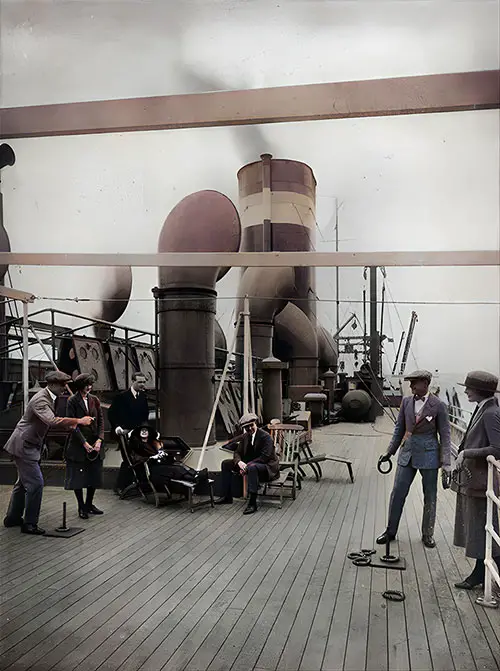
Passengers Playing Quoits on the Boat Deck of a United States Lines Steamship circa 1922. GGA Image ID # 1795313aa6
In playing this game, six rope rings are used. The object is to throw the largest number of rings over a spindle attached to a horizontal piece of wood that sets on the vessel's deck.
The proper distance for throwing the rings is eight feet for ladies and twelve feet for gentlemen. The start is usually made nearer to the spindle, and the distance is then increased.
The score is kept upon a small blackboard, which is usually provided, or with pencil and paper. Any number of persons can play the game.
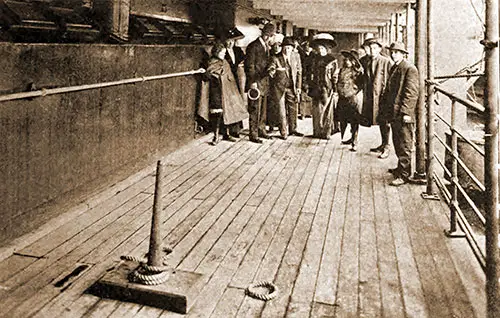
First Class Passengers Playing A Game of Quoits on a Sheltered Promenade Deck. GGA Image ID # 1795486283
History
Of all out-door games quoits is probably the oldest, as it is said to have originated with the Greeks, and to have been first played at the Olympic games by the Idaei Dactyli, fifty years after the deluge of Deucalion, 1453 B.C., when he who threw the discus furthest, and with the greatest dexterity, gained theorize.
Homer represents hurling the quoit or discus as forming one of the funeral games instituted by Achilles in honor of Patroclus, described in Iliad XXIII.
We are also told that it was in consequence of his inadvertently killing his grandfather when throwing a quoit that Perseus, the grandson, left his kingdom of Argos, exchanging it for Mycenae in 1313 B.C. These notices are sufficient to show the great antiquity of the game.
It has always been popular in England, in spite of the reported declaration of Henry the Fifth, that "he as cordially hated the game as the devil did holy water."
It is now played very much in the rural districts of England, and more especially in Lancashire, Durham, and the Midland Counties, where matches are of frequent occurrence.
The Play
The modern quoit, as everyone is aware, is a much lighter missile than the discus, consisting of a circular iron ring, flattened, with a thick inner edge and a thin outer one, which is slightly indented so as to receive the tip of the player's forefinger.
The weight may be unlimited, but it is usual to determine this point previous to a match. The diameter is restricted to eight inches overall. The two "hobs," consisting of iron pins, are usually pitched nineteen yards apart.
There may be more than one player aside, each being provided with two quoits, which he may either throw successively or in any order previously agreed upon.
After each round, the throwing takes place the reverse way. The best way to hold a quoit is to grasp it with the forefinger along the outer edge and the tip in the dent, keeping the two surfaces between the thumb and the other fingers.
In pitching it, the player should endeavor to put on a slight spin with his wrist, so that the missile may pass smoothly and at an angle of about 30 deg. to the ground horizontally through the air, and ultimately alight not flat, the great aim being to make the quoit pitch so as to ring or encircle the hob pin, or failing that to get as near the pin as possible.
For a ringer two is scored. If both quoits are "ringers" the player scores four. If the opposing quoits alight at an equal distance from the ring, nothing is scored.
If, however, a player has both his quoits nearer the pin than any of the opposing side, he scores two, as in bowls; if one only is nearer, he scores one.
Eleven points constitute the game for two players, fifteen when four are playing. Strength in the arms and shoulders, and quickness of sight, with a capacity for measuring distance, and dexterity of wrist, are indispensable requisites for this game.
A conference of players was held at Birmingham in 1869 to draw up the rules, which in the main are the same as the London Club Rules.
The former rules, however, definitely settled that no quoit be allowed to measure more than eight inches in external diameter. That the decision of the I umpire be final in all cases is, we trust, generally understood.
LONDON CLUB RULES
- The distance from pin to pin shall be nineteen yards. The pins shall be one inch at least out of the clay.
- The player shall stand level with the pin and deliver his quoit with the first step. He can throw two quoits in succession, or alternately if so agreed upon.
- The order of playing shall be determined before the commencement of the game. The winner at each end shall take the next first throw.
- The game shall consist of eleven points unless some other number is agreed upon.
- No quoit shall count unless fairly delivered into the clay.
- No quoit rolling shall count unless it first strikes another or the pin.
- All dead quoits shall be removed before the next player throws.
- Measurement shall be taken by compasses, or by a string looped on the pin; no clay may be flattened or disturbed.
- The quoits nearest the pin count and a ringer counts two. If opponents throw ringers neither counts.
A Game of Shuffle Board
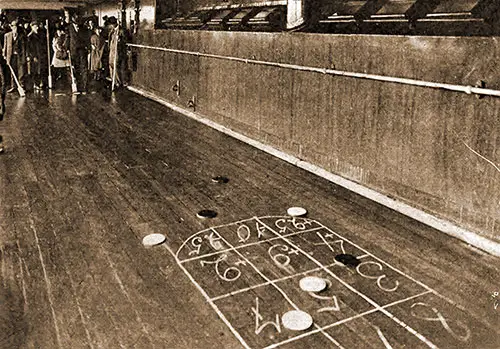
Passengers Play a Game of Shuffle-Board on the Lower Promenade Deck. GGA Image ID # 1795a9d71d
The staple game, which remains most popular throughout the voyage with the largest number of passengers, is “ Shuffle Board ." It is a light sport , yet provides sufficient exercise to create considerable fatigue, if the player chooses to exert himself. It is somewhat like the game of pool.
Cues, with half-moon shaped head and a handle five feet in length , are used to drive round blocks. The latter are from six to ten inches in diameter across the top surface .
Two goals or " fields" are marked out on the deck about twelve strides apart. Each field is about six feet long with oval or straight ends, as the players prefer, and straight sides four feet from each other.
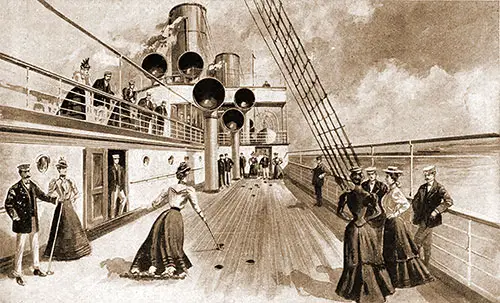
Passengers Enjoy a Game of Suffleboard on a Hamburg-American Line Twin-Screw Express Steamer. GGA Image ID # 17a5ee7852
The square within the oval ends are divided into nine equal squares, numbered so that, no matter in which direction they are counted in threes, the total will amount to fifteen , the total number in the nine squares being forty-five.
The inside ovals are marked " ten off ” and the outside “ ten on ." If the player's block stops in the first he sacrifices ten points, while if it reaches the outside pocket he gains ten .
If one player' s blocks land on numbers and not on lines, his opponent immediately attempts to knock them out, at the same time placing his own block in one of the pockets. Skillful shots may clear the field which would have totaled a large score.
Though it requires considerable skill to use the large score. Though it requires considerable skill to use the cue, in a few hours one may easily become a good player. Shuffle board tournaments are both exciting and diverting.
Amusement Afloat
Other Sports and Pastimes Indulged in by Passengers on Board Modem Transatlantic Steamships.
The wonderful phenomena seen in both sky and water are among the delights of shipboard, but the informal sports and amusements, when all formality and stiff convention are cast aside, provide no small part of the pleasure of an ocean voyage.
Many games are indulged in, some for the vigorous and athletically inclined, and others, milder, for those desiring to be somewhat indolent on the trip.
There need never be an unfulfilled desire for those seeking strenuous exercise for it onboard a large steamship. And to the travelers who indulge most actively in these beautiful sports, mal-de-mer has lost most of its terrors.
Placing the Pig's Eye
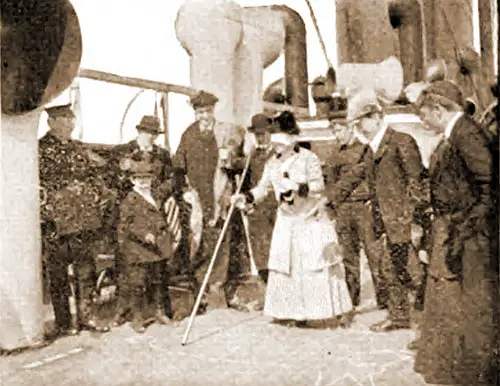
Passengers on a German Ocean Liner Enjoy Playing a Game of Placing the Pigs Eye on Deck. GGA Image ID # 17a617fc88
"Placing the Pig's Eye" is copied after the old Halloween game of "Donkey's Tail." At least five feet long and three feet high, the outline of a pig is chalked out on the deck.
The first "artist" is blindfolded, and a light pole, or shuffleboard cue, is placed in his hand. From a point fifteen feet from the "pig," he is started, with instruction to place the eye where Nature intended it to be.
Though commencing on the right course, the laughter of his fellow-passengers and their many "helpful suggestions" completely confuse the player, and he either marches directly to the tail—to the intense amusement of all—or chalks the eye half a dozen steps away from the proper spot.
Sling the Monkey
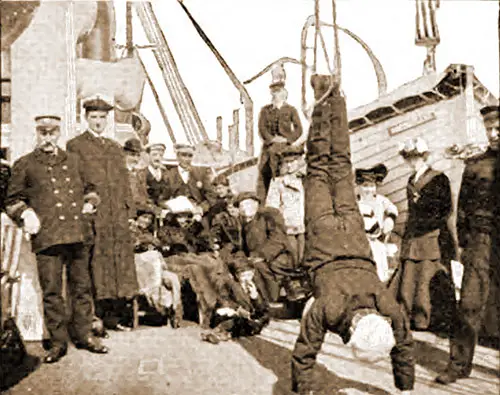
Passengers on a German Liner Play the Game of Sling the Money as a Ship's Officer Looks On. GGA Image ID # 17a6671fc2
Strength of arm and good control of body muscles are necessary to the victor in the ludicrous game of "Sling the Monkey." A seaman mounts the shrouds and fastens a thirty-foot rope to the ratlings.
A noose two feet long is fashioned at the lower end of the rope, about four feet from the deck. The first "victim" gets down upon his hands, and his feet are inserted in the noose.
With a large portion of the body's weight, thus resting upon the hands, the "monkey" is ordered to walk backward. In this absurd position, the wrong end up, he must chalk lines as he progresses.
The "monkey" placing the mark furthest away wins. In his struggles to keep a perfect balance, the contestant will gyrate around and around, clawing frantically at the deck.
When he has finally reached a satisfactory point and throws his weight on one arm and hand, in order to draw his line, he is at times whirled back amid shouts of laughter.
The difficulty of the feat can hardly be appreciated until one has played the "monkey" with an unstable deck to contend with and jeers and numerous words of advice ringing in his ears.
The Blind Duel
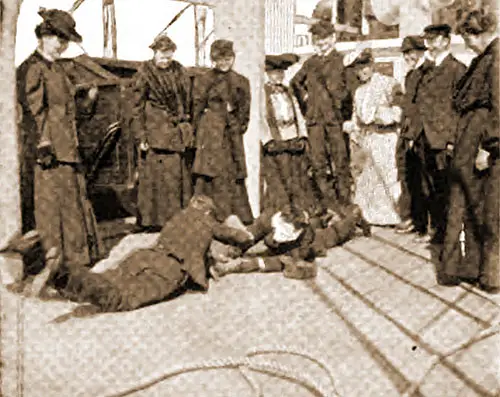
The Game of Blind Duel is Played by Passengers Onboard a German Liner. GGA Image ID # 17a67a5a60
Another mirth producing sport is, "Are you there?" or the "Blind Duel." Two "duelists" are blindfolded and commanded to lie flat on the deck, face downward.
They are placed head to head, extended full length, and just far enough apart so that they can clasp their left hands. In the right hand of each is placed a large roll of paper as a sword.
At the word "Go," one "duelist" rises on his elbow, still holding the hand of his opponent, and cries, "Are you there? "When the other answers "Yes," the first attempts to strike him over the head with the roll. In order to avoid the blow, the Second, the moment he replies, dodges with head or body to a point where he believes his opponent's "sword" will not fall.
As each vainly attempts to locate his foe by the sound of the voice and hits the deck violently and fruitlessly, the onlookers are convulsed with merriment. The victor in this novel duel is he who scores the largest number of successful blows in a given time.
As a muscle test and an incentive to friendly rivalry, the tug-o’-war is excellent entertainment both for participants and spectators. As many as choose may lay hold of the long rope, making two big teams, but, as a rule, teams of eight are pitted against each other.
A regular tournament maybe "runoff," the winning team becoming victor over all the others. In this sport, the fair sex enters equally with its sturdy brothers or husbands.
On the center of the rope, a handkerchief is fastened and placed directly over a mark on the deck. Then, as "the tide of battle" flows, the "flag" will move backward or forward, marking the ebb and flow of victory.
Tug-o-War
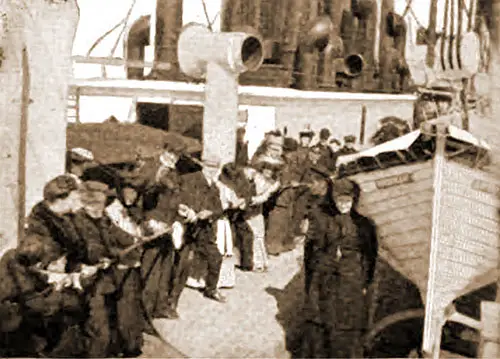
A Game of Tug-o-War is Played on the Boat Deck of a German Steamship. GGA Image ID # 17a7bbc1e8
Wrestling and boxing and the game with the undignified name of "Swat" are popular in the steerage. On their lower decks, the boys and men tussle or pummel each other for the edification of their fellow-voyagers or create amusement with "Swat."
In this latter game, the one who is" it" bends from the waist downward and forward, clasping his hands behind his back and placing his face in the locked hands of a "director."
The other players form a circle around the two. At a sign from the director, one of the players strikes the man, thus blinded, upon the back. If the victim is able to whirl in time to detect and also slap the one striking the blow, the latter must be "it."
Though the cabin passengers seldom indulge in this game, they have generally amused spectators of it.
Military Tournament
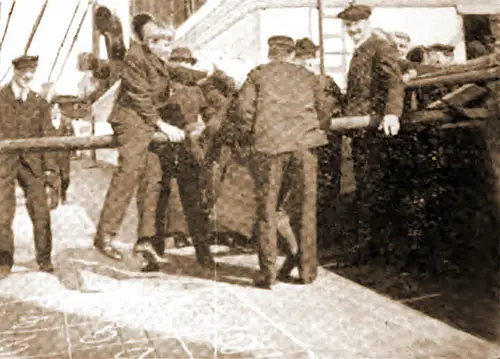
A Game of Military Tournament Played on the Deck of a German Ocean Liner. GGA Image ID # 17a7bf9f02
From the pillow fight, which has come down to us from the earliest nursery lore, the amusing "Military Tournament" is taken. A boat's mast is lashed to two supports about four feet from the deck and in a position horizontal with it.
Two opponents mount this "riding-the-rail" fashion and armed with large pillows, attempt to knock each other from their unstable seats.
A mattress or pad is thrown beneath the spar to protect the fighters from the hard deck. When the word to start is given, one player strikes a heavy blow at his enemy, and the force of his own effort often tumbles him ignominiously to the mat.
Up he jumps, and, as he is almost safely mounted, a blow on the side of the head may again land him on the floor.
Wrestling in Steerage
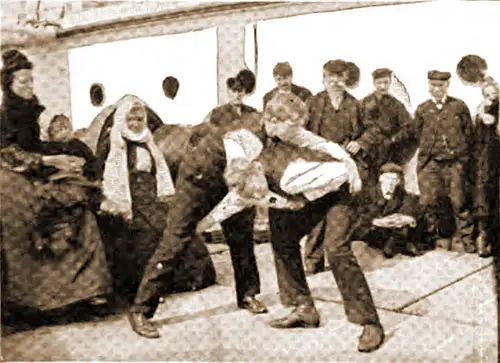
A Westling Match in the Steerage of a German Ocean Liner. GGA Image ID # 17a805e366
His opponent has been successful for the moment, perhaps, but with his own blow precipitates himself. The small mast is a difficult seat, and clever and agile must be the "duelist" who long retains his position.
For a laugh-producing exhibition, the game can scarcely be surpassed by any other of the amusements peculiar to an ocean voyage.
"Ginger ale and bun,*' human wheel-barrow, potato races, and cockfighting are all entertaining. In the first game, each contestant is provided with a bottle of ginger ale and a biscuit. He must entirely consume these, without spilling the ale or throwing away a morsel of the bread before he begins to race.
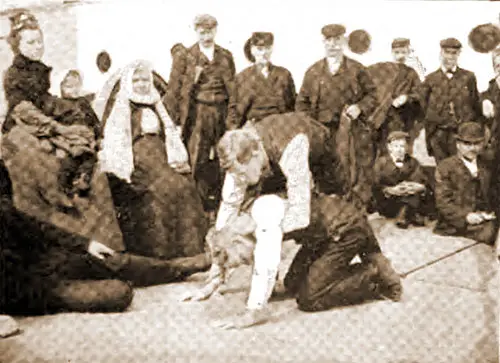
The Wrestler on Top Holds His Opponent Utilizing a Half-Nelson. GGA Image ID # 17a83e1a0b
The difficulty of running fast with a mouth full of dry bun after drinking the carbonated liquid rapidly may well be imagined. In cockfighting, an eight-foot ring is chalked on the deck and the two contestants seat themselves upon the flooring, placing a cane within the crook of the knees which are drawn close to the body.
The ends of the cane are then caught in the hollows of the elbows. In this awkward position, the fighters endeavor to push each other, rooster fashion, out of the circle.
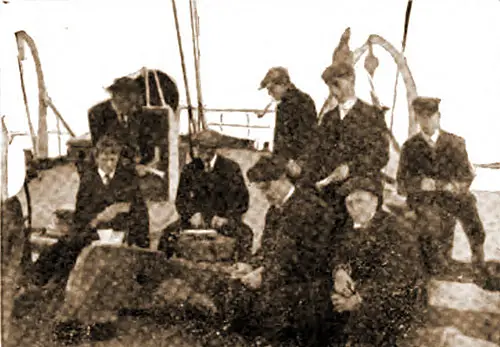
Designated Scorekeepers Maintain the Scoring for the Games. GGA Image ID # 17a89befab
